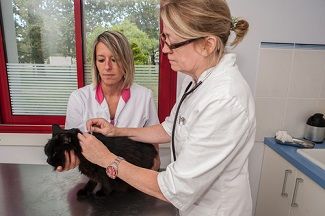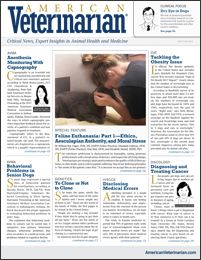Diagnosing and Treating Cancer
The basics of cancer care: identifying tumor type, staging, and treatment.

Like people, pet dogs and cats are living longer due to medical advances and an increased focus on preventive care and nutrition. Living longer exposes our pets
to diseases of aging, including cancer.
Clients want to know 3 things when a pet is diagnosed with cancer: What type of cancer is it? How extensive is it? How can it be treated? In a forum at North Carolina State University (NC State), Steven Suter, VMD, MS, PhD, DACVIM (Oncology), shared tips for diagnosing and treating cancer in pets based on answering these 3 basic questions.
“What Is It?” Identifying Tumor Type
In many cases, veterinarians can identify the cancer category (carcinoma, sarcoma, or round cell tumor) during the initial appointment, said Dr. Suter, who is director of the Canine/Feline Oncology Diagnostic Laboratory and medical director of the Canine Bone Marrow Transplant Unit at NC State. Pinpointing the category is crucial because tumors in different classes behave differently with respect to metastasis and response to therapy.
Fine-Needle Aspiration
Fine-needle aspiration is a low-cost, low-risk, rapid method to identify tumor category (but not grade), Dr. Suter said. He dis- cussed tips for obtaining fine-needle aspirates.
- If an aspirate has low cellularity, try again with a larger needle, use suction if you did not on the first attempt, and be more aggressive (the procedure is rarely painful).
- Evaluate only intact cells.
- Be sure the sample accurately represents the mass.
Inflammatory changes can look like neoplasia, he cautioned. Criteria for malignancy include anisocytosis, anisokaryosis, increased nucleus:cytoplasm ratio, high mitotic index, basophilic cytoplasm, and multiple or prominent nucleoli. He described cytology characteristics of tumors of different categories:
- Carcinomas: These tumors are epithelial in origin, so the cells tend to clump together on the slide. Anal sac adenocarcinoma cells have minimal anisokaryosis and almost no cytoplasm. Squamous cell carcinoma cells may have nuclei, unlike normal squamous epithelial cells.
- Sarcomas: Aspirates of these mesenchymal-origin tumors typically include more blood and fewer nucleated cells than do aspirates of the other tumor types. Osteosarcoma yields cells with very eccentric (off-center) nuclei.
- Round cell tumors: These tumors “love to give up their cells,” Dr. Suter said. High-grade lymphosarcoma aspirates may include lymphoglandular bodies (small blebs of cytoplasm outside cells) and cells with a thin rim of basophilic cytoplasm.
Biopsy
Biopsy is the diagnostic gold standard, said Dr. Suter, who offered the following tips:
- Avoid Penrose drains as they increase the risk for tumor seeding.
- Avoid cauterizing the margins, use proper fixation, and provide an appropriate case history when submitting samples.
- Request a microscopic description on the pathology submission form so the report will include the mitotic index.
“Where Is It” Cancer Staging
Cancer staging is costly, but it is the only way to determine the tumor burden and uncover concurrent diseases (including other cancers), Dr. Suter said. Clients should understand the reasons for staging before deciding whether to pursue it. Staging includes a complete blood count and biochemistry profile, urinalysis, aspiration of regional lymph nodes, thoracic radiographs, abdominal ultrasound, and advanced imaging if indicated and if finances allow.
Sarcomas tend to metastasize hematogenously, he said, so thoracic radiographs are crucial for staging these cancers. Carcinomas spread through lymphatics, making fine-needle aspiration of lymph nodes necessary; be aware that some cancers skip nodes or spread to contralateral nodes. Round cell tumors are systemic and can metastasize to any location.
“How Can I Get Rid of It?” Cancer Treatments
Dr. Suter gave a broad overview of the 3 treatment modalities available for companion animals: surgery, irradiation, and chemotherapy/immunotherapy. In general, he said, surgery and irradiation are used for local control and chemotherapy is used for systemic control.
Surgery
The best way to remove a solid, visible tumor is by surgical excision, he said. For cancer that has not metastasized, surgery can be curative if the margins are large enough. Dr. Suter underscored the following points.
- Do not “shell out” a tumor; tumor capsules are composed of compressed cancer cells.
- Remove as much normal tissue as possible that will still allow wound closure.
- Ideal margins are greater than 1 cm; margins less than 5 mm are concerning.
- Obtain very large margins with feline injection-site sarcomas and high-grade mast cell tumors.
Irradiation
Irradiation can be either definitive (curative) or palliative. Curative irradiation targets microscopic disease; high-dose stereotactic radiation can also be used as definitive treatment. Palliative radiation is designed to slow or stop tumor growth and can also be used to control osteosarcoma pain, he said.
Chemotherapy
Chemotherapy is used as the primary treatment for hematologic cancers and to control metastasis of solid tumors. The main goal in veterinary medicine is maintaining a good quality of life; therefore, to avoid toxicity, doses are lower and protocols are less intense than in human medicine. For this reason, the cure rate with chemotherapy is very low, Dr. Suter said, although chemotherapy does extend life span in dogs with some types of cancer.
The Final Answer
Ultimately, the role of the veterinarian is to advise the client, who will then decide how aggressively to pursue staging and treatment, Dr. Suter said. “Our job is not to get them to make a [particular] decision,” he said. “Our job is to present the options and let them make the decision.” In general, more aggressive treatment will prolong life. However, because pet owners also take into account cost and the pet’s age, options should not be framed as right or wrong, he said.
Dr. Walden received her doctorate in veterinary medicine from North Carolina State University in 1994. After an internship at Auburn University College of Veterinary Medicine, she returned to North Carolina, where she has been in companion animal general practice for over 20 years. Dr. Walden is also a board-certified editor in the life sciences and owner of Walden Medical Writing.
